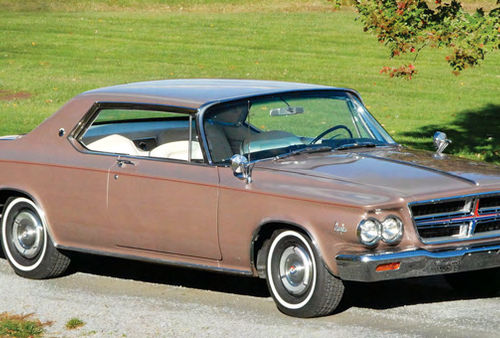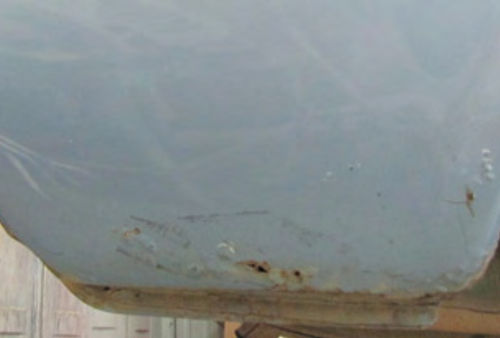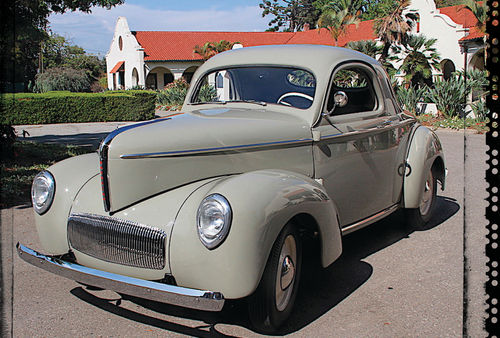1967 Amphicar
A little red convertible speeds along Italy’s Amalfi coast. A small black sedan filled with bad guys follows in hot pursuit. Imagine James Bond at the wheel of the convertible, steely-eyed, looking for a way into the sea. There it is! The red Amphicar heads for the boat ramp and takes a dive into the water. In the distance, the island of Capri beckons. The bad guys are left at the water's edge, swearing oaths, as our hero navigates his way to yet another narrow escape.
No, this never happened, but it could have! The Amphicar has that kind of dramatic flair for providing the ‘great escape: David: Punaro, owner of our’: feature car: came across this 1967 Amphicar in 1990 when he was strolling through the lot of a collector car dealer. He was captivated by the concept of a car that could “drive” in the water. The Amphicar he spotted was complete, but in bad shape. It ran poorly, was full of rust and the interior was awful — it was love at first sight. Punaro was not in the market for a new project car, but he bought it anyway. Punaro’s short-term goal was to get the car into the water. But first he had to make it run well. He bought new plugs, points, condenser, cap, rotor and wires from his local parts store. Since the Amphicar’s engine is the same as the powerplant for a Triumph Herald, the parts were easily found “off-the-shelf.” A major tune up worked wonders in this case. The engine started and ran reliably. “I thought there might be more serious engine problems,” Punaro recalls, “but once I tuned it up, it ran great.”

The next challenge was to repair the body to make it seaworthy. Punaro looked down into what should have been the watertight engine compartment and could see through to the pavement below. Worse still was a right quarter panel so rusted away that it flapped in the breeze as he drove along the street. The dealer from whom Punaro bought the Amphicar arranged to have some body work done at a reduced cost. “I didn’t have a lot of cash at the time,” says Punaro, “I just wanted it leak-proof.”
The body shop used a combination of fiberglass and Bondo to do the repairs. “When they were done,” Punaro says, “it looked pretty good, considering what they had to work with.”

Six months after purchasing his Amphicar, David Punaro was finally ready for his first “sea trials.” He and a couple of friends drove to the harbor in Oceanside, California. He’d been working on the car all day and had to splice some wires to get all the running lights working. It was 8 p.m. and the sun was beginning to set when they arrived at the water's edge. Within a few minutes, a small crowd had gathered, sensing something interesting was about to happen. Punaro checked the tightness of the bilge plug, then got in and headed down the boat ramp. After a very short maiden voyage, he drove the car out of the water to the cheers of amazed onlookers. He removed the bilge plug to see if the car was watertight, and was surprised to see it was completely dry. With his confidence buoyed, he drove the car back into the water for a 15-minute cruise. Everything was still watertight. “At this point I was pleased with the car and really got the bug to restore it,” Punaro says. But another distraction — Punaro’s purchase of a Bricklin — diverted his attention from the planned Amphicar restoration. “The Amphicar was functional and I'd take it out every so: often: says Punaro, “but, I knew I’d get back to it eventually.”
In early 1996 Punaro realized his salt water excursions had taken their toll on his little car. The half-shafts needed repair and more of the body was showing signs of rust. Hugh Gordon of Gordon Imports, the country’s largest Amphicar parts supplier, directed Punaro to Danny Escobar at the Plaza Body Shop in Norwalk, California. Escobar expertly fabricated new sheetmetal to replace the rusted sections of the quarter panels. He sealed all the body joints to make it watertight, and painted the bottom of the “hull” black. The bumpers and a few trim parts needing plating were sent out. Escobar repaired all other rusted areas before applying the red acrylic enamel paint.

From Gordon Imports, Punaro bought new half-shafts, wheel bearings and watertight transmission boots for the rear end rebuild. He also bought new accelerator and clutch cables, both of which run under the floor. He removed the interior to install the cables. Punaro had the seats redone by Sickels’ Upholstery in Escondido, California. Sickels used the original seat covers as a pattern to create the new ones they installed.

When the freshly painted Amphicar came back from the body shop, Punaro noticed the original door seals had been stripped off. He replaced them temporarily with sticky-back weatherstrips until he could get the correct replacement seals. These don’t work as well as the correct seals, but will be adequate until the replacements are installed. Punaro’s next goal is to fully detail the engine compartment — that is, if he can keep it out of the water long enough.

Amphicar Basics

The first Amphicar prototypes were built in Germany in 1960 and production by the Quandt Group began the following year. Amphicars were first imported into the United States in December 1961 and sold through their own dealer network. A few were even sold by Montgomery Ward stores. Between 1961 and 1967, 3700 Amphicars were imported into the United States and Canada. Total Amphicar production was approximately 4500. It’s estimated that there are 900 driveable/sailable Amphicars in the United States, with another 200 seaworthy cars scattered around the world. It is estimated that an equal number of Amphicars exist in various stages of disrepair. When production ceased, the stock of parts was purchased to service existing vehicles. Gordon Imports of Santa Fe Springs, California, purchased this stock in 1980 and is the primary supplier to owners and restorers. Amphicars sold in the United States were all basically the same. They were available in four solid colors: red, blue, white and aqua, with red and white the most popular.
Some cars were delivered with an AM radio, but most radios were installed by dealers. The dealers also added accessories like an exterior rearview mirror, an anchor and life jackets. Because it’s a fully operational boat, an Amphicar must be licensed as such and carry all safety equip-. ment mandated by the U.S. Coast Guard when operating in the water. The mechanics of an Amphicar are simple. It has an in-line, rear-mounted, water-cooled four-cylinder engine. Its cooling is provided by a rear-mounted radiator. The engine is connected to a four-speed manual transmission that drives the rear wheels on land and spins the twin propellers in the water. The same floor-mounted clutch is used for both.

There are two shift levers on the front floor — one for the four-speed manual transmission and one to engage the propellers. The shift lever for the propellers is much shorter and has three positions. In the forward position, the twin screws propel the car forward in the water; in the rear position, the twin screws will reverse vehicle direction; and the center position disengages the propeller drive and is used when driving on land or at anchor. It’s possible to engage both gear-boxes at the same time. But spinning the propellers on land, which is not recommended, will not help the car attain a higher top speed, and driving the rear tires in the water will just make a lot of bubbles. The standard floor-mounted accelerator pedal is used for land and water, but there’s a throttle holder, mounted on the instrument panel, for water use only. Steering in the water is accomplished by turning the steering wheel, which turns the front wheels act ing as twin rudders.
The transition from land to water in an Amphicar is an interesting operation. The car is driven down the boat ramp in first gear using the brakes to keep from entering the water too fast. Any first-time passenger is certain the car will sink as soon as the front of the car enters the water. But all of a sudden you can feel the front become buoyant as the rear tires enter the water. Next the clutch is depressed, the land transmission is slipped into neutral, and the water drive into forward. Once fully in the water, it feels like any small boat. The freeboard — the distance between the waterline and sinking — Is minimal (21 inches) and one has the impression that a large wake would wash over the side.
Getting out of the water takes a little more finesse than getting in. The Amphicar must be driven directly at the boat ramp ata slow speed. As the craft gets near the ramp, the land transmission is placed in first gear anda little power is applied. With both propellers and the rear wheels driving the car, it will pop out of the water smartly and drive up the ramp. The tricky part is getting enough grip with the rear tires on the wet incline to get all the way up the ramp to level ground. Once on land, the brakes, even though soaked, work amazingly weil if relined with the correct Amphicar lining material.
Amphicar Buying Guide
The most important questions to ask someone who's selling an Amphicar are: will it float, and for how long? This one factor — the floating factor — determines the true value of the vehicle. The current president of the International Amphicar Club, Jeffrey Sweet, says, “You're looking not only at a Car, but at a boat. Is it serviceable as a boat?” According to Sweet, an Amphicar should float indefinitely.
There are three water-seal areas on an Amphicar. All are critical and all tend to leak. First are the door seals. There are two on each door — one on the body and one on the door. They should _mate together for a watertight seal. Some owners have opted to use a generic adhesive-backed weather strip from a local parts house. These generic seals will not restrain the water sufficiently. The correct seals are available from Gordon Imports for approximately $100.

The second area that will leak is the steering column seal. Usually the leakage around this area is minimal and the bilge pump will easily handle it. The third area that needs | to be watertight is around _the U-joint boots on the transmission. If one of these breaks while in the water, your car/boat will become a submarine within two minutes. A good schedule of preventive maintenance will keep an Amphicar high and dry. The body/hull of an Amphicar is completely welded and very sturdy. The Amphicar’s engine is modified from the unit that powered the Triumph Herald and its electrical system is by Lucas. Parts originated from a variety of sources that are traceable today. For instance, front turn-signal lamp assemblies, outside door handles, convertible top moldings and weatherstripping are from Mercedes and back-up lamps and lenses are from BMW. Engine parts and some mechanical parts for an Amphicar are available from local auto parts stores. The car is easy to work on because of its simplicity.
The transmission is expensive and becoming limited in supply. When Pp in water, a small amount of water may seep into the transmission case.
This small amount of water will not damage the internal transmission components, but an accumulation of water in combination with freezing winter temperatures have resulted in more than a few cracked cases. Salt aged because of the damage they will do to the integrity of the body. Also recommended is a yearly wheel-bearing service.
Every five years, replace the rear axle seals.
















